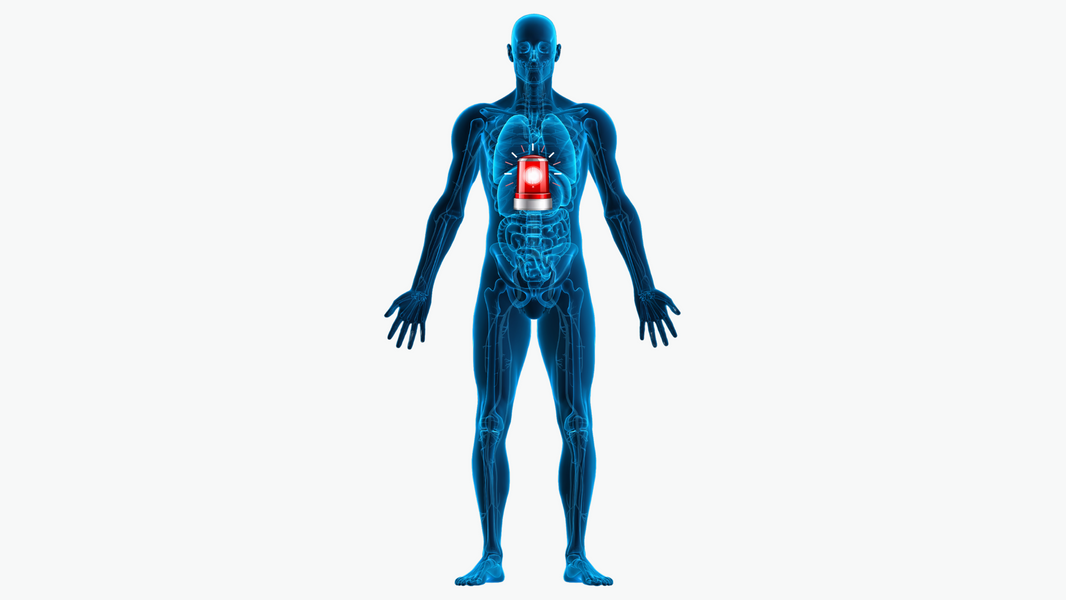Rewriting the Narrative on GLP-1
You've probably heard about GLP-1 medications like Ozempic, Wegovy, or Mounjaro. Maybe your doctor mentioned them, or perhaps a friend shared their experience. But here's something most people don't know: your body already produces GLP-1 on its own. Yes, naturally.
The conversation around GLP-1 has become almost exclusively focused on synthetic medications, creating the impression that this powerful hormone is something we need to inject or that our bodies lack entirely. This narrative has overshadowed a fundamental truth: GLP-1 is one of your body's most sophisticated regulatory systems, designed to keep your blood sugar stable, your appetite balanced, and your metabolism humming.
This isn't about denying the value of medication when it's medically necessary. Rather, it's about understanding what your body is already capable of and exploring how to work with your natural biology first, not against it. Too often, we reach for external solutions before we've even given our internal systems a chance to function optimally.
Your body is remarkably intelligent. It has been regulating blood sugar, managing appetite, and coordinating metabolic processes for thousands of years without pharmaceutical intervention. The question isn't whether you need GLP-1, it's whether you're supporting your body's natural ability to produce and utilize it effectively.
What Is GLP-1 and Why Does It Matter?
Glucagon-like peptide-1 (GLP-1) is a hormone produced primarily in your intestines, specifically in specialized cells called L-cells that line your small intestine and colon. Think of GLP-1 as your body's natural appetite dial and sugar stabilizer, a sophisticated communication system that coordinates multiple aspects of your metabolism.
When you eat, particularly when you consume nutrient-dense whole foods rich in fiber, healthy fats, and quality proteins, these L-cells spring into action. They release GLP-1 into your bloodstream, where it begins an intricate dance of metabolic coordination that most people never think about but rely on every single day.
GLP-1's natural role is remarkably comprehensive. First, it regulates blood sugar by stimulating insulin release from your pancreas, but only when your blood glucose levels are elevated. This is called glucose-dependent insulin secretion, a built-in safety mechanism that prevents dangerous drops in blood sugar. Simultaneously, GLP-1 suppresses glucagon, another hormone that raises blood sugar when it's not needed.
But GLP-1's influence extends far beyond blood sugar management. It significantly slows gastric emptying, the rate at which food moves from your stomach to your small intestine. This creates a natural sense of fullness that lasts longer, reducing the urge to overeat or snack between meals. It also communicates directly with your brain, particularly the hypothalamus, signaling satiety and reducing food-seeking behavior.
Perhaps most fascinating is GLP-1's role as a messenger between your gut, brain, and pancreas. This represents one of the clearest examples of the gut-brain axis in action, where the health of your digestive system directly influences your neurological and hormonal responses. When this system works optimally, you experience stable energy, appropriate hunger cues, and effortless weight management.
 GLP-1 Medications: What They Do (and Don't Do)
GLP-1 Medications: What They Do (and Don't Do)
GLP-1 receptor agonist medications like semaglutide (Ozempic, Wegovy) and liraglutide (Victoza, Saxenda) exist for valid clinical reasons. They were originally developed to help people with Type 2 diabetes achieve better blood sugar control when other interventions weren't sufficient. Their expansion into weight management reflects their powerful effect on appetite regulation and metabolic function.
These synthetic versions work by mimicking your body's natural GLP-1, but with some key differences. Pharmaceutical GLP-1 agonists are designed to last much longer in your system than the natural hormone, which typically breaks down within minutes of release. This extended duration creates more sustained effects on appetite suppression and blood sugar control.
The medications work by binding to the same GLP-1 receptors throughout your body, triggering similar responses to natural GLP-1 but with greater intensity and duration. This can lead to significant weight loss and improved glycemic control, which explains their popularity and clinical success in appropriate populations.
However, there are important distinctions between synthetic and natural GLP-1. The medications often produce side effects including nausea, vomiting, diarrhea, and in some cases, more serious complications like gastroparesis (delayed stomach emptying) or pancreatitis. These side effects occur because the synthetic versions don't have the same regulatory mechanisms as your body's natural production.
Natural GLP-1 production is inherently self-regulating. Your body produces it in response to food intake and stops production when it's not needed. Synthetic versions don't have this built-in feedback system, which can lead to excessive effects and unwanted symptoms.
Additionally, medications address the downstream effects without necessarily correcting the underlying factors that may have disrupted natural GLP-1 production in the first place. Factors like poor gut health, chronic inflammation, insulin resistance, and inadequate nutrition can all impair your body's ability to produce and respond to GLP-1 naturally.
This doesn't make medications inherently problematic, but it highlights why they aren't always the first or only solution. For many people, restoring natural GLP-1 function through targeted nutrition and lifestyle interventions can provide similar benefits with fewer risks and greater long-term sustainability.

The Power of Your Natural GLP-1 System
Your body is a masterpiece of biological engineering, and it already has the GLP-1 blueprint built in. The key is understanding how to activate and optimize this system through the choices you make every day.
Natural GLP-1 production is remarkably responsive to the foods you eat. Research suggests that high-fiber foods like vegetables, fruits, and legumes stimulate GLP-1 release more effectively than processed alternatives. Soluble fiber, found in foods like oats, apples, and beans, feeds beneficial gut bacteria that produce short-chain fatty acids (SCFAs), which studies indicate may directly stimulate L-cells to produce more GLP-1.
Research suggests that healthy fats also play a crucial role. Omega-3 fatty acids from sources like wild-caught fish, walnuts, and flaxseeds may support the structural integrity of L-cells and enhance their sensitivity to food-based triggers. Monounsaturated fats from olive oil, avocados, and nuts provide sustained energy that doesn't spike blood sugar, creating an optimal environment for balanced GLP-1 release.
Studies indicate that quality proteins, particularly those containing specific amino acids like leucine and arginine, can stimulate GLP-1 production while providing the building blocks your body needs to manufacture the hormone efficiently. This is why whole food protein sources like grass-fed meats, wild fish, and organic poultry may be more effective than processed protein powders or bars.
Polyphenols, the colorful compounds found in berries, dark leafy greens, and herbs, have been shown in research to support GLP-1 production and protect L-cells from oxidative damage. Studies suggest that polyphenol-rich foods may enhance natural incretin hormone function, though individual responses vary.
Research indicates that movement and blood sugar balance also significantly influence natural GLP-1 function. Regular physical activity, particularly after meals, may enhance GLP-1 sensitivity and help maintain stable blood glucose levels that support optimal hormone production. Studies suggest that even a 10-minute walk after eating can improve GLP-1 response.
The mind-gut connection appears to play an equally important role. Research indicates that chronic stress elevates cortisol levels, which may impair L-cell function and reduce GLP-1 production. Stress management techniques like meditation, deep breathing, and adequate sleep may support the parasympathetic nervous system, creating an internal environment where GLP-1 can function optimally.
This isn't magic or wishful thinking. It's your biology responding to nourishment and support. Multiple studies have demonstrated that whole food, anti-inflammatory approaches can significantly enhance natural GLP-1 production and improve metabolic outcomes.

Why We Start Natural at Betr
At Betr, our philosophy centers on root-cause healing and working with your body's innate wisdom rather than overriding it. We believe food is medicine and that your body has an extraordinary capacity for self-regulation when given the right support.
Our three-level approach, Purification → Reintroduction → Maintenance, is specifically designed to restore natural GLP-1 function through targeted nutrition and lifestyle optimization. Level 1 focuses on removing inflammatory foods that may be disrupting L-cell function and gut health. Level 2 systematically reintroduces foods to identify personal sensitivities that might impair GLP-1 production. Level 3 establishes sustainable practices that maintain optimal hormone balance long-term.
These improvements aren't coincidental. They reflect your body's remarkable ability to respond to proper nourishment and support. This is what Betr members describe as "remembering how to feel good again." It's not that we're doing something extraordinary, we're simply removing barriers and providing the building blocks your body needs to function as it was designed.
The power of this approach extends beyond just GLP-1 optimization. When you support natural hormone production through whole food nutrition and lifestyle practices, you create positive changes throughout multiple body systems. Gut health improves, inflammation decreases, energy increases, and mental clarity enhances. These interconnected improvements create a foundation for lasting health transformation.
When It Makes Sense to Go Further
It's important to acknowledge that some individuals may benefit from GLP-1 medications, particularly those with severe insulin resistance, Type 2 diabetes, or obesity-related health complications. We're not categorically against pharmaceutical interventions when they're medically appropriate and carefully supervised.
However, the current healthcare model often positions medications as the first line of treatment rather than exploring natural optimization first. Many people receive prescriptions for GLP-1 agonists without ever addressing the lifestyle factors that may be disrupting their natural hormone production.
This approach misses a crucial opportunity. When underlying factors like gut dysbiosis, chronic inflammation, nutrient deficiencies, or food sensitivities remain unaddressed, even successful medication-based weight loss may not be sustainable long-term. Additionally, the side effects and costs associated with chronic medication use create additional burdens that many people would prefer to avoid if natural alternatives prove effective.
Our position isn't anti-medicine, it's pro-informed choice. We believe people deserve to understand all their options and to try the least invasive, most sustainable approaches first. For many individuals, natural GLP-1 optimization through targeted nutrition and lifestyle changes provides the metabolic benefits they're seeking without the need for ongoing pharmaceutical intervention.
Even for those who do ultimately choose or require medication, establishing a foundation of optimal nutrition and gut health can reduce the doses needed, minimize side effects, and improve overall outcomes. The two approaches can be complementary rather than mutually exclusive.
The key is making decisions based on individual circumstances, medical history, and response to natural interventions rather than defaulting to medications without exploring your body's inherent capacity for healing and self-regulation.

Supporting Your Natural GLP-1 with the Betr Method
The Betr Method naturally stimulates GLP-1 production through several interconnected mechanisms that address the root causes of hormonal imbalance rather than just managing symptoms.
Our clean nourishment protocols prioritize foods that are scientifically proven to enhance GLP-1 secretion. This includes emphasizing prebiotic fibers that feed beneficial gut bacteria, which produce metabolites that directly stimulate L-cells. Foods like asparagus, artichokes, onions, and garlic contain inulin and fructooligosaccharides (FOS) that support this process.
We also focus on gut repair and blood sugar balance through strategic food combinations and timing. By pairing fiber-rich vegetables with quality proteins and healthy fats, we create meals that promote sustained GLP-1 release while preventing the blood sugar spikes and crashes that can impair hormone sensitivity.
The anti-inflammatory focus of the Betr Method is particularly important for GLP-1 optimization. Chronic inflammation can damage L-cells and reduce their ability to produce GLP-1 effectively. By eliminating inflammatory foods and emphasizing anti-inflammatory nutrients like omega-3 fatty acids and polyphenols, we create an internal environment where natural hormone production can flourish.
Our coaching approach helps members rewrite their health stories, starting with their biology rather than their willpower. This is crucial because the relationship between stress, mindset, and hormone production is profound. When people understand that their challenges with weight, energy, and appetite regulation may be physiological rather than psychological, they can approach solutions with self-compassion rather than self-criticism.
The Betr community provides accountability and support that enhances adherence to practices that support natural GLP-1 function. Social connection and shared experiences reduce stress and provide motivation, both of which support optimal hormone production.
Perhaps most importantly, the Betr Method is personalized to each individual's unique gut microbiome and metabolic profile. We recognize that what stimulates GLP-1 production in one person may not work optimally for another. Through systematic testing and observation, we help each member identify their personal formula for natural hormone optimization.
This represents the natural activation of your body's built-in brilliance. Rather than overriding your natural systems, we're supporting them. Rather than forcing changes through external interventions, we're removing barriers and providing support so your body can function as it was designed.
The results speak for themselves. Betr members consistently achieve significant improvements in weight management, energy levels, blood sugar control, and overall health markers through natural GLP-1 optimization. Many report that they feel better than they have in years, with sustainable changes that don't require ongoing medical intervention.
A New Chapter in Your Health Story
The narrative that your body is broken and needs to be fixed is both inaccurate and disempowering. You're not broken, you're just out of rhythm with your own biology. The solution isn't to trick your body with medications when natural optimization hasn't been attempted. The solution is to trust your body and provide it with what it needs to function optimally.
This shift in perspective is transformational. Instead of viewing yourself as someone who needs a pharmaceutical fix, you can embrace the identity of someone who supports their body's natural wisdom. Instead of believing you lack willpower or have "bad genetics," you can recognize that you simply haven't been given the right tools and information to work with your biology effectively.
Your body wants to be healthy. It wants to maintain stable blood sugar, appropriate appetite, and efficient metabolism. It has sophisticated systems like GLP-1 production specifically designed to achieve these goals. When these systems aren't working optimally, it's usually because they're not being supported properly, not because they're fundamentally flawed.
This realization is both liberating and empowering. It means that your health challenges likely have solutions that don't require lifelong dependence on medications. It means that your body has capabilities you may not have known existed. It means that the power to transform your health may already be within you.
The identity shift from "someone who needs to be fixed" to "someone who is already healing" changes everything. It affects the choices you make, the way you treat your body, and your expectations for what's possible. When you truly believe that your body is capable of remarkable self-regulation and healing, you begin to make choices that support these natural processes.
This isn't about perfection or never needing medical care. It's about starting with the assumption that your body is wise and capable, then providing the support it needs to demonstrate that wisdom. It's about giving natural approaches a genuine opportunity before concluding that pharmaceutical intervention is necessary.
Your health story doesn't have to be one of progressive decline managed by increasing medications. It can be one of discovery, optimization, and increasing vitality as you learn to work with your body rather than against it. The choice is yours, and the first step is as simple as providing your body with the nourishment and support it needs to activate its natural GLP-1 production.
 Ready to Activate What Your Body Was Designed to Do?
Ready to Activate What Your Body Was Designed to Do?
The power to optimize your natural GLP-1 production and transform your metabolic health is already within you. Your body has the blueprint, the systems, and the capability. What it needs now is the right support, guidance, and nourishment to activate these natural processes.
Starting your Betr story means choosing to work with your body's wisdom rather than against it. It means providing your gut with the nutrients it needs to produce GLP-1 naturally. It means creating an internal environment where your natural appetite regulation, blood sugar control, and metabolic function can operate optimally.
You'll feel the difference on Day 1. Not because we're performing miracles, but because your body is finally getting what it needs to function as it was designed. The energy stabilizes, the cravings diminish, and the constant battle with your appetite begins to ease. This is your natural GLP-1 system coming back online.
Getting Started with Betr:
Check Your Insurance Coverage: Many health insurance plans now cover the Betr Method. Check if you're eligible for coverage by visiting our insurance verification page to see if your plan is included among the 40+ carriers that recognize Betr as a preventive health benefit.
Sign Up Directly: If your insurance doesn't cover Betr yet, you can enroll directly through our individual programs.
Employers & Health Plans: If you're interested in bringing Betr to your organization or health plan, schedule a consultation to learn how we're helping companies reduce healthcare costs while improving employee wellness outcomes.
Health Plan Benefits Manager Click Here
The time for guessing, struggling, and fighting against your own biology is over. The time for supporting, nourishing, and trusting your body's innate wisdom has begun. Your transformation story starts now, with the next choice you make about how to fuel and support your remarkable body.
Disclaimer: The information provided in this article is for educational and informational purposes only and reflects our company's approach to wellness. This content is not intended as medical advice, diagnosis, or treatment. Always consult with qualified healthcare professionals before making changes to your health regimen, especially if you have existing medical conditions or are taking medications. Individual results may vary.
References
Scientific Concepts Referenced:
The article discusses established scientific concepts including GLP-1 hormone function, L-cell physiology, glucose-dependent insulin secretion, the gut-brain axis, and the role of fiber, polyphenols, and gut microbiome in metabolic health. These concepts are supported by extensive research in endocrinology and gastroenterology journals.
Additional Resources:
Betr Health. (2024). "The Betr Method: Clinical Outcomes and Member Success Data." Internal research compilation.
- Clinical outcomes data from over 30,000 Betr members showing improvements in metabolic markers through natural interventions.
Centers for Disease Control and Prevention. (2024). "National Diabetes Statistics Report." U.S. Department of Health and Human Services.
- Current diabetes prevalence and risk factor data referenced in the article.
The information provided here is for general knowledge and educational purposes only. It should never replace personalized medical guidance from your physician or another qualified healthcare provider. We do not offer medical advice.






